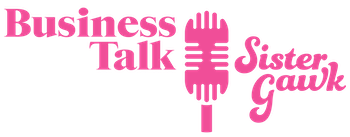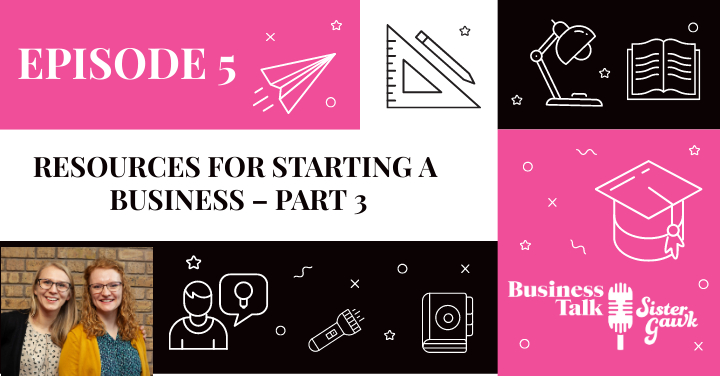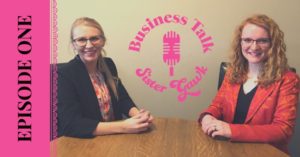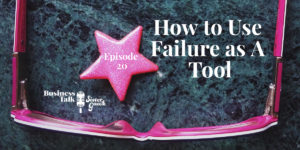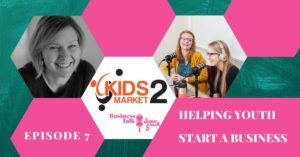In this episode, we talk all about the different tools available to get paid as an entrepreneur, do your accounting, and organize all your projects. If you hear about a tool that you like, we have all the links to these different websites on our Tools & Tips page of our website www.businesstalksistergawk.com!
Disclaimer: We have NOT been paid to talk about any of the tools mentioned in this episode.
Free & Almost Free Accounting Software for Starting A Business
Bekkah: Today we’re going to be talking about more free resources that you can use to keep your business organized as well as doing your accounting, bookkeeping, and payment processing. We’re gonna start with the accounting and bookkeeping side and jump into some payment processing tools towards the end. The first tool we’d like to share are some accounting software that allows us to keep all of our business documentation in check. One free tool that we really like is called “Wave“. It’s actually titled something like “Waved App” or something if you’re gonna check out the link on our website. By the way, all of these are linked on our website in the “Tools & Tips” page.
So anyway “Wave”, is a totally fee program. Generally speaking, you can run an entire business without paying any money. However there are some exceptions. They’ve got to make money somehow, right? They charge for their add-on payroll service – like if you wanted to have employees in the future – and they charge if you want to get paid via credit card. There’s a processing fee for you to do that, but the nice thing is that if you do get paid that way, Wave will auto deposit the payment into your bank account; which is really nice because you don’t have to worry about doing all of that extra work.
Ruthie: What I like about it is that you can make custom invoices and things like that. Like you can add in your own logo and your own slogan if you wanted to. You can also add your contact information, and things like that. Plus it will send you an email when you have an invoice that’s overdue. So if you send and invoice to someone and they haven’t paid you yet it’ll send you back the invoice. I think that’s really nice because it helps you stay on top of your costs and your in-going and out-going accounting.
Bekkah: Yeah and they also have a dashboard that shows you how much money you’ve made over time. It’ll show you cyclical patterns so you can what months are more profitable than others. Another thing I really like about it is that it has an app that goes with it. The app lets you take pictures of your receipts and it will process them into your accounting, so you don’t have to save all of your physical receipts. The paperless system is really nice, especially if you’re on the go like traveling. This way you don’t have to worry about losing receipts, you can just take pictures of them and upload them right to the app. You can keep them all within Wave and again, it’s totally free!
Yeah, okay so payment processing in general, though… Let’s be real, if you take someone’s credit card you’re going to have to pay a fee regardless of what company you go through. That’s how credit cards and debit cards work; anything digital is going to cost money to use.
So the next accounting tool that we really like, sometimes you can get it for free, otherwise the price is around less than 200 dollars a year to use, is QuickBooks Self-employed.
What I really like about this version of QuickBooks is the app. The app will track your mileage for you when you drive places. It’ll say, “Hey was this trip for business?” and then you can just easily say yes or no and it’ll document it. The program also syncs really well with TurboTax if you happen to use that for your taxes and you pay your taxes that way. I love doing my own taxes but some people don’t so they get an accountant to do it – which is totally fine. But yeah, so that feature is really nice. Oh, also you can send invoices from there.
So what’s the difference between Wave and QuickBooks? If I were to compare them side-by-side, Wave can sometimes be kind of glitchy. You can get double entries in your banking account system. For example, if Wave tracks what’s happening on your card versus what’s happening as a transaction on your bank account, you’ll have to reconcile that monthly. That can sometimes cause a couple issues. I know that they’ve been doing a lot of updates lately to make that a little bit more seamless, but QuickBooks already has really nice user support and flow. I mean, let’s be real, you get what you pay for.
Ruthie: It’s honestly worth the investment for Quickbooks.
Bekkah: Yeah but we haven’t even talked about the third accounting system yet – Zip Books! Ruthie and I really like this platform as well. The primary reason why we like them is because it also works with PayPal now. Did you know that you can send invoices through PayPal? I recently started looking into that.
Ruthie: I did not know that!
Bekkah: Yeah! You can use it as a primary payment processing system. We really like that Zip Books is that it pairs well with payment terminals. If you’re doing physical credit card processing you will need a terminal. Say for example that you have a coffee shop and you need people to insert their chip… Zip Books actually functions well with square. Square is one of the different terminals that you might commonly see in little boutiques and coffee shops or other little independent places.
Ruthie: It’s the thing that people attach to like their phone or iPad. Those things.
Bekkah: Another payment processing company that we’d like to mention is Clover. Sometimes these companies will charge you for the payment processing terminals, so it’s best to compare them side by side to determine what will best fit your needs. I know that some banks actually offer terminals as well, but in my experience they tend to be a little bit more expensive. So those are some different options. If you’re looking at having an in-store terminal, you might want to use Zip Books. But you might want to look at QuickBooks, too, to see if they have any terminals that pair well with them.
Online Payment Processing Options to Start Your Business With
Bekkah: For online payment processing we really like Stripe. In the research that I have done, this is one of the most inexpensive payment processing systems on the internet. If you’re thinking about putting a shopping cart plug-in in your website or maybe using Shopify – I’m not really super familiar with the backend of Shopify or how they process payment – if you use WordPress, Stripe is a really good way to get paid through your shopping cart feature. Stripe also deposits directly to your bank account, which is really nice. They do have a processing fee, so look into it and make sure it’s really a good option for you. Even so, we like them because they’re secure and they they’ve do a really good job of helping you as a small business owner. You’ll just have to put the snippets of code in your website to get all that connected.
Ruthie: It’s really important if you do have a website to have something like this or another payment processing system. If you try to process the payment yourself, you’ll be responsible for documenting all of those credit card numbers and you can actually be fined if you hold them for longer than what the customer has agreed to. So what’s nice about having a processing system like Stripe, is that Stripe is responsible for holding onto those credit card numbers for whatever time period.
Bekkah: Yeah okay so the next one is PayPal. PayPal’s branding totally reminds me of those early, tacky, 2000’s websites and I always associate it with eBay because that’s the first place I ever experienced it. And I believe they kind of grew up together as best friends, right? But anyway, what’s nice about PayPal is that you can process and use it like a bank account. You can store all your money there and if you’re going back and forth paying for things on the internet. It can function that way if you need it to. Another thing that’s nice about it is that when you have processed over twenty thousand dollars through it, they’ll actually send you a form that you can use on your taxes to say, “Hey, this is how much money I made through this.”
It makes it a little bit easier to document sales of a side hustle but you can also export that data and import it to another accounting system if you want to use it that way. You can also add it as a button to your website so that your customers can pay you through PayPal. There’s a pretty easy way to do that, so if you’re starting a side hobby or if you’re going to use eBay you should totally get a PayPal account. I just recently learned that I can even use PayPal to pay for my bus fare on the local Metro. That was a lot more convenient than putting in my credit card information while I was sitting on the bus. So that’s nice. The following payment processing system is Venmo and Ruthie’s going to tell us a little bit about that.
Ruthie: Venmo is kind of like the child of PayPal. They are… I think Venmo was bought out by PayPal. What I think is nice about this is that it’s very, very popular with people who are my generation.
Bekkah: Gen Z
Ruthie: I’ve seen people use it all the time in college. If you go to the grocery store or something it’s just a really, really easy and fast way to be able to pay your friends back if they buy something for you. Or something like that, especially if you forgot your wallet. Which happens to me a lot! Anyway, what I like about it is that has a really easy user interface. They’ve almost made look like a social media platform instead of traditional payment processing.
Bekkah: You can publicly shame people who have not paid you!
Ruthie: Okay, or on a more positive note – you can like, say I was going to pay Bekkah for a pair of shoes, or something like that. I can share that publicly so that other people can see that I paid her. Or some people will sometimes just say goofy things and then or you can make it private. I think you can just switch that manually where you make those payments.
I don’t think you can do it automatically. Anyway, so that’s how I got paid in school, and it was really fast and efficient. I also had a log so I was able to know, “Okay this is when I received this payment, this is when I received this payment.” It was really nice and easy to be able to keep track of that and all parties were kept accountable that way.
Bekkah: Yeah so that’s an option for situations where you need to make a direct transfer of money. It’s free to use as an individual.
Ruthie: The only times where they charge you is if you want to take out money that you have in your account – if you want it done like right now, then they’ll charge you. But if you just let it take three days to transfer into your bank account, or two days, or however long, then it’s free.
Bekkah: Yeah, so basically, the time value of money, right? If you can be patient you don’t have to pay anything but if people are paying you with a credit card they charge you a fee. So that’s important. If you’re looking at using Venmo for business, it functions almost identically to PayPal since it’s kind of the hipster version of the PayPal after being bought out. So it charges you a processing fee for credit cards. As I’ve already said though, most companies that offer credit card processing will charge you. I think the going rate for most competitive companies is around 2.9 percent right now. However, PayPal will also charge you 30 cents for each transaction so that’s important to note if you’re thinking about going with them.
I don’t know if I mentioned this when I was talking about PayPal, but like Ruthie was saying, You can get immediate payments for free through Venmo , but if you want PayPal to pay you out they will actually charge you a percentage fee for paying you through a bank transaction. That’s kind of a bummer. They can cut you a physical check which I find is a lot of times to be cheaper, but it still usually costs about a $1.50 every time they send you a physical check in the mail. Just make sure to put that into your operating costs to determine when the most lucrative time to send yourself a check might be.
Something to look out for with PayPal is that they will not send you a check that’s more than, I believe, three thousand dollars. So know that when you think about good times to be cashing out that money and putting it in another bank account. Also, if you’re using PayPal to pay for everything… let me know how you do that! I have never been able to figure out how to use my PayPal account to buy groceries. I’m sure there’s a way but I haven’t found it. Anyway, definitely think about that.
The next category we wanted to talk about is organizational task management. Some of you have been asking about to keep all your stuff organized. What should you be using? We really love these tools and we’re going to tell you about them.
Task Management & Organizational Tools to Increase Efficiency Within Your Business
Ruthie: So the first one is Asana, and I absolutely love asana. I use it for pretty much everything in my life whether that’s my daily to do’s or it’s my grocery list. I even have a template on there that I use every time I pack to go somewhere so that I can just look and see what things I need to bring with me. Basically i’s a glorified checklist. It’s super awesome! It let’s you assign dates to tasks, you can assign them to different people, and you can share projects with people so that they can see all the tasks that they’re responsible for. When my best friend got married she and I used it to help with a lot of the wedding planning. It was a great way to keep track of who was responsible for what and when. Plus now I have a really nice wedding template, so if you need one let me know!
Bekkah: Hit her up! What I personally like about Asana, because I’m cheap, is that it’s free for a single user. If you’re going to use it for a business with multiple employees you will have to pay for that.
Ruthie: but it is well worth the investment. There’s a lot of versatility that comes with it. You can add a whole bunch of different plugins. You can even add time tracking to each task, if you want to utilize that for your business. That’s really nice.
Bekkah: It’s the bomb for accountability! But it has to make sense for your business. If you only have one employee it may not be something that you really need since you’d probably have more time to help that employee know what they’re working on.
Ruthie: They can use it for free, too. There’s a lot that you can do with the free version and I really like it a lot.
Bekkah: And I really like the fact that I can take screenshots and attach them to my tasks; “oh here’s the image that goes along with that,” or “here’s the link and keeps everything digitally.” They also have an app so you can get it on your phone, too, if you want to.
Ruthie: I get notifications on my phone for the tasks that are due each day, which is something I find useful.
Bekkah: Yeah you can set it up to receive emails and say, “Here’s what you’re going to do today!” If you are an achiever in your Strengths Finder this is literally the way to get your endorphin overload.
Ruthie: Sometimes when you check off a task it’ll even send a little surprise animal across the screen. Kind of like it’s saying, “Hey! Good job! You did that!” It’s usually a unicorn or a colorful narwal or something.
So anyway, the next tool that we have for organizational management is called Calendly.
Bekkah: Like Asana, Calendly is free to use for the basic features. What I love about it is that it allows me to book a meeting with someone based on my availability without having to share all of my private calendar information with them. I can set it up to show the days and times that I’m actually available. That way I can cut out all the back and forth. Basically, I can cut out all the “When are you available? Well, why don’t you – what about this week? What about this week?” etc. It’s easy enough, you just send a link and you say, “Here you go. Go ahead and book something that works for you.”
Ruthie: Mm-hmm and can set it to… So the way that I have my Calendly set up is that I have it linked through my business email, but I have it set up to pull in my personal calendar as well. That way if there’s something that I have blocked off on my personal calendar Calendly blocks it off on my schedule. I’ll also have it pull for some things on Bekkah’s calendar. That way, if Bekkah has something scheduled on there then people can’t book me during that time. Basically, it pulls in all the different appointments that are scheduled on my personal calendar, my business calendar, and Bekkah’s calendar so that people can only book me during the times when I know I’ll be available.
Bekkah: Yeah and everything she does with it is free.
Ruthie: There is some really nice features that you can use. Like, you can utilize PayPal within Calendly. That way if you want someone to pay before a meeting you can set up payment processing through Calendly and set it so your clients will have to pay beforehand in order to book a meeting. That is a paid feature though.
Bekkah: Wow, I didn’t know that
Ruthie: Yeah. You can also set it up so that people will get email notifications an hour before your meeting or a day before your meeting, or set times like that. They can also get text notifications, but those are also paid features.
Bekkah: Yeah but, let’s be real, when you’re first starting out you probably won’t need all that. What’s nice about the Calendly link in general is when you’re like, “Yeah, let’s book a meeting here’s my calendar link,” all of a sudden all people over the age of 50 are thinking, “Wow you are so professional!” which is awesome. Because we like Calendly, we could not go any further without saying that Google is something we love. And we’re not the only ones; we’ve actually talked to quite a few entrepreneurs that love Google. Specifically, the the Google suite.
We use Google Calendar. It allows you to share your schedule with different levels of privacy. Calendly utilizes that information so people aren’t seeing your dentist appointments, as that would be awkward. But it is really nice to being able to share things back and forth. Since we share calendars, I know exactly when Ruthie has meetings because I can see them on my own calendar. In addition, we can invite each other to meetings. What I, personally, love about it when I’m driving – well not while I’m driving but right before I’m about to leave the house – is that I can just pull up on my calendar and see, “oh there’s the address for my meeting location that I saved in here,” and it will just auto-connect to Google Maps. Then boom, you’re on your way.
Google Email is another one we have to mention here because we use it a lot. I really like the instant chat feature. It’s great for quick back and forth communication and for sending links. That way you don’t flood somebody’s inbox with tons of emails. You can use this if they also have a gmail account. The other awesome thing about this is if you’re setting up a website and you have your hosting domain name all that stuff, instead of paying for a Google business account you can actually use a free one. You’ll just go into like the user settings where there’s mirroring option to have an email account that your hosting provider has created for you hooked to your gmail account.
Ruthie: So, basically, instead of like [email protected], our email now says [email protected] because we were able to use this mirror process to get our domain name as the @businesstalksistergawk.com.
Bekkah: For free!
Ruthie: Which is really nice! And it just makes you look more professional. I don’t think there’s anything wrong with having @gmail.com but it does make it look a little more classy when you can say @domainname.com
Bekkah: Ok, so here’s an example for why having an @gmail.com address could be a problem. Looking like you’re a legitimate business, with a domain so people can look up your website and see what you’re actually about could be really important. Say you were to contact a supplier in a different country – say like Indonesia or China or something – and you said, “I really want to order X amount of product and this is what I need blah blah blah blah.” If you send the request from an @gmail.com they’re probably going to think, “You are just a random person how can we trust you?” I mean, they probably get a ton of dreamers and spammers all the time.
What will give you legitimacy and tell them that they can take you seriously is their ability to go on your website and see what you’re already doing and if you already have a whole bunch of products that you’re selling. They’re going to want to see the proof before they’re going to send you a quote. Otherwise it’s a waste of their time, right? And so, especially when you’re doing international stuff, having an official looking email address really does give you a lot more credibility.
Bekkah: Have a great rest of your week! We’ll see you next week!
Thank you for listening to this episode of Business Talk Sister Gawk! We hope you find these tools as useful for your business as we have for ours. Remember that you can find all the information mentioned here in our Tools & Tips page. If you found this information helpful or know of someone else who might enjoy the show please feel free to bring us up in conversation or share us on social media.
Until next time,
Bekkah & Ruthie
